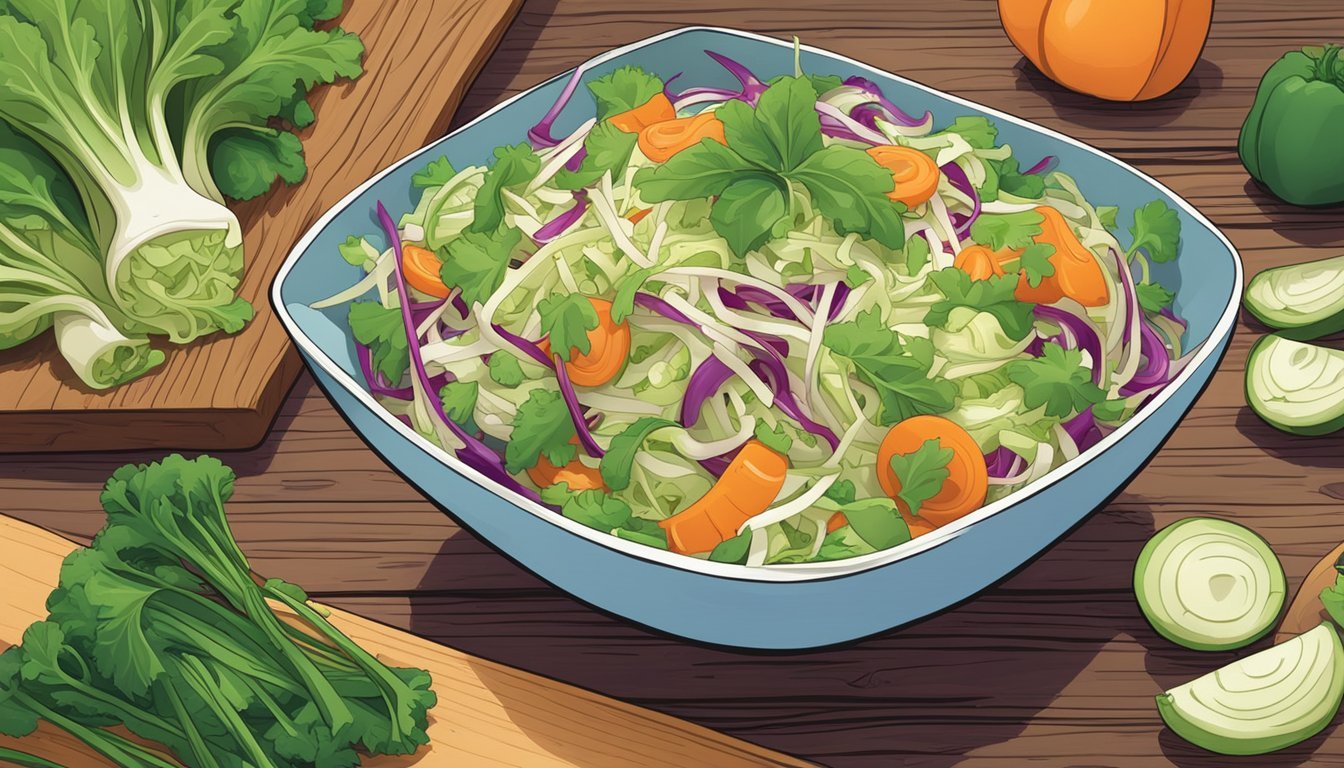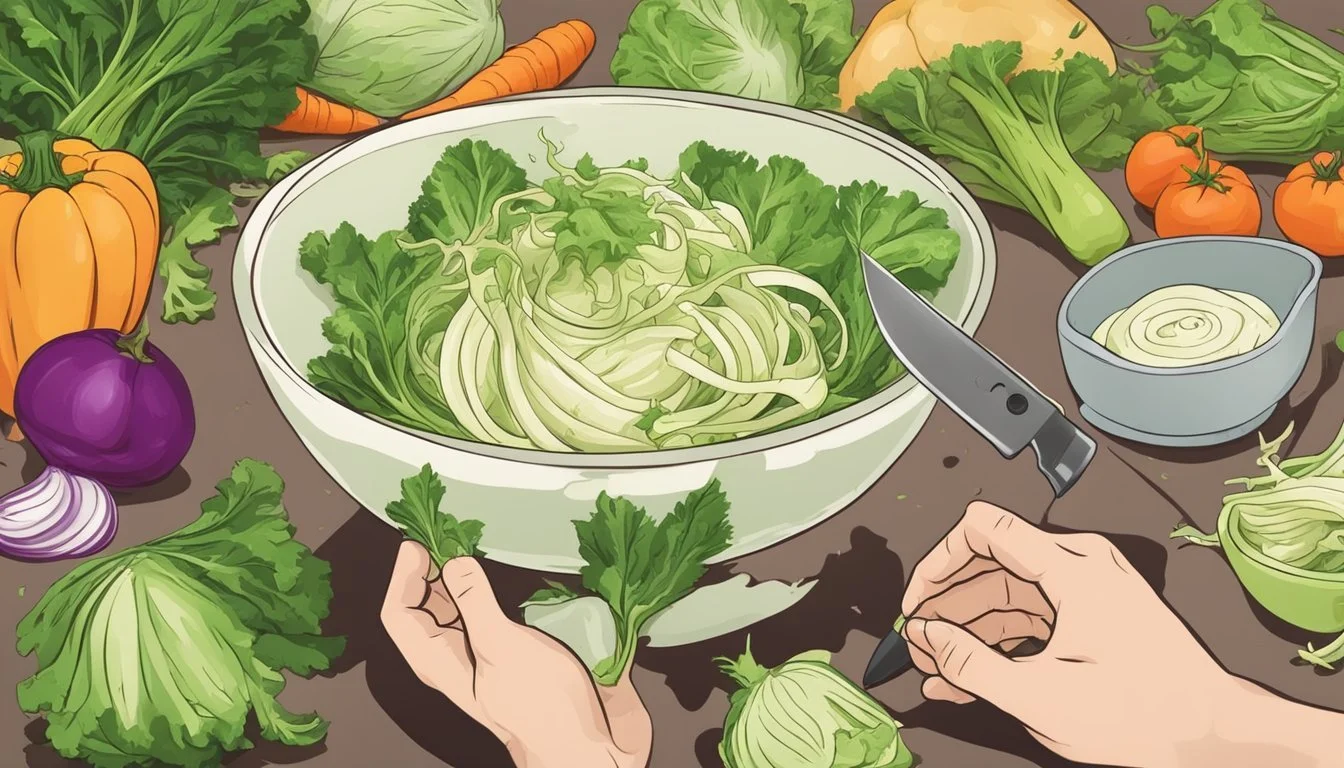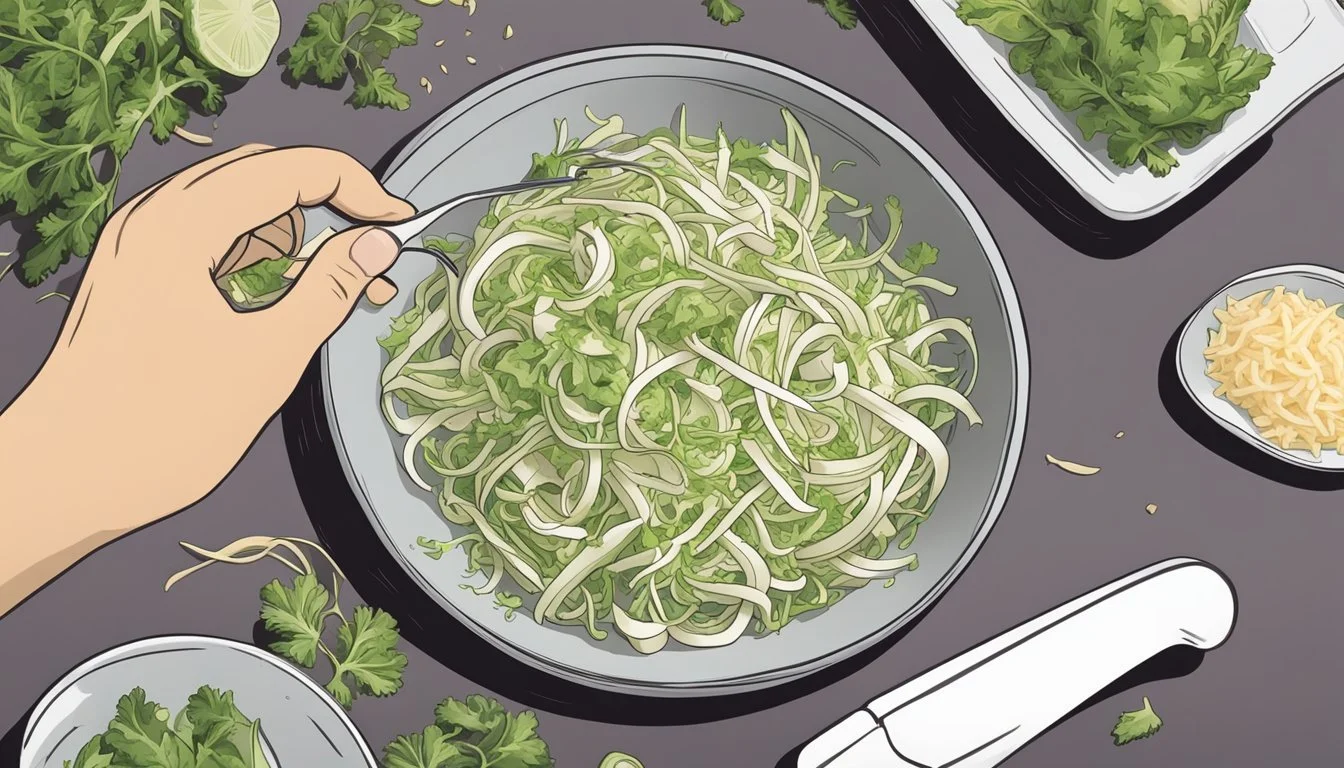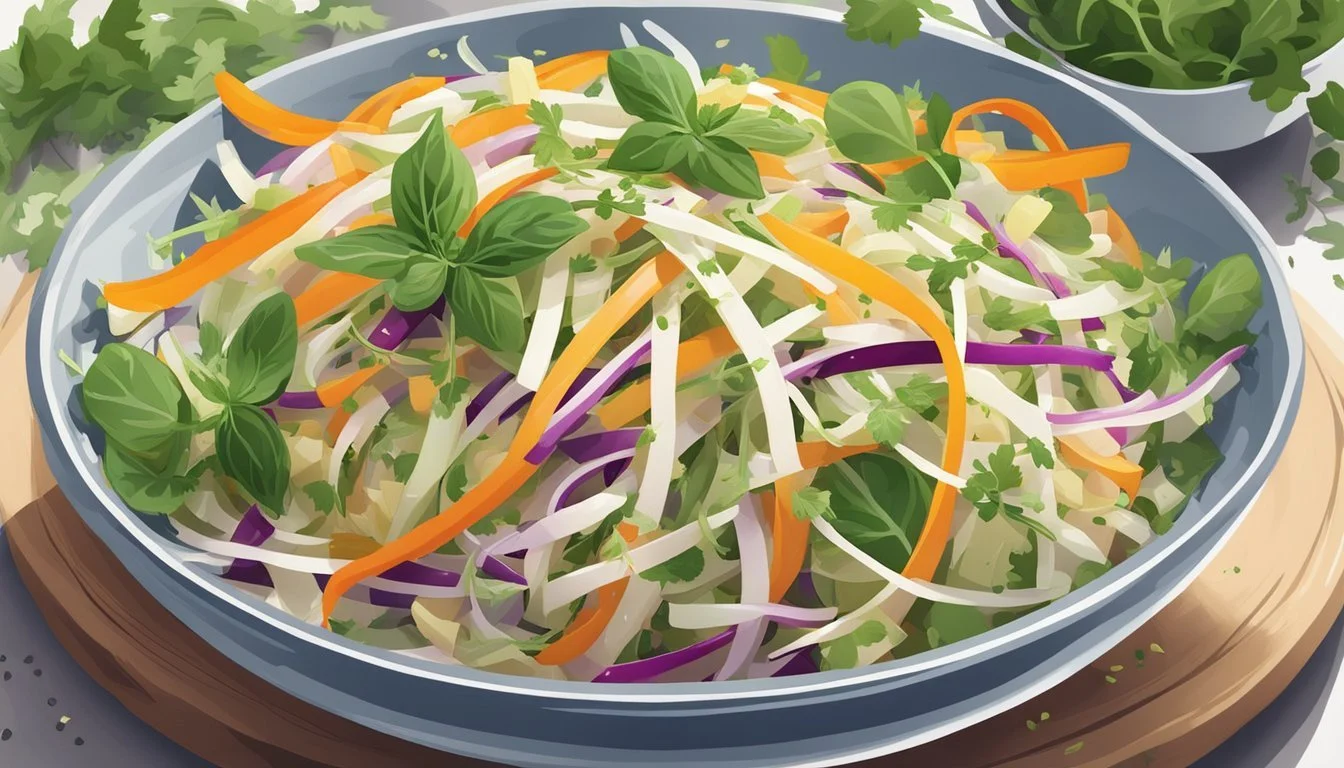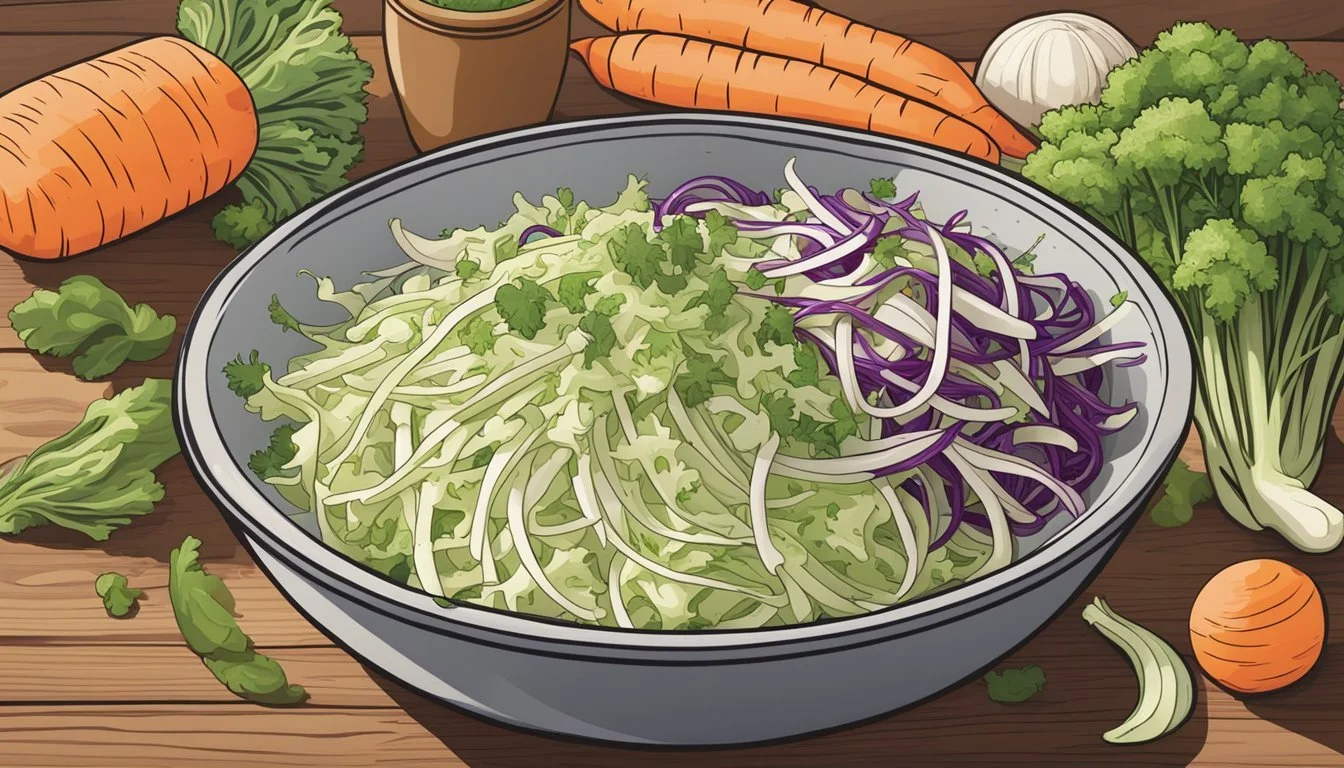Kohlrabi Peel Slaw
Elevating Salads with a Unique Crunch
Kohlrabi, a vegetable that might not make regular appearances in the produce section of grocery stores, is on the rise for its versatility and nutritional benefits. This sputnik-shaped vegetable, a member of the brassica family which includes cabbage, broccoli, and kale, offers a pleasant crunch and a slightly sweet, nutty flavor. It is gaining popularity in culinary circles for its adaptability in a variety of dishes, but particularly shines when used raw in slaws.
Kohlrabi slaw presents a fresh take on traditional slaws, distinguishable by its crisp texture and refreshing taste. Upon preparing the kohlrabi by removing its thick skin, it can be thinly sliced or grated to serve as the base of the slaw. Complementing ingredients, such as apples for sweetness, onions for bite, and carrots for an earthy undertone, can be added to enhance the flavor profile of the dish.
In the realm of dressings, a simple vinaigrette made of oil, vinegar, and a touch of mustard is commonly whisked together to coat the slaw, creating a blend that's light yet satisfying. Unlike its cabbage-based counterparts that can sometimes feel heavy, kohlrabi slaw is known for its ability to add a bright and crunchy component to a meal without overshadowing other flavors. This dish proves to be a delightful choice for those seeking a nutritious side that pairs well with a variety of main courses.
Understanding Kohlrabi
Kohlrabi is a versatile vegetable that offers a unique taste and a host of nutritional benefits. It is becoming increasingly popular in salads (What wine goes well with salads?) and slaws for its crisp texture and refreshing flavor.
Origins and Culinary Uses
Kohlrabi, a member of the brassica family, originated in Europe and has been a staple in German cuisine (What Wine Pairs Perfectly With German Cuisine) for centuries. It is a round, stout vegetable with green or purple skin and a white, fibrous interior. Kohlrabi is not just limited to German dishes; it is commonly used in various culinary traditions worldwide, featuring in salads, soups, and as a steamed or sautéed side dish. Its leaves are also edible and can be prepared similarly to collard greens or kale.
Kohlrabi Taste Profile
The taste of kohlrabi is often described as a pleasant cross between a sweet apple and a radish, with a slight peppery kick. When eaten raw, kohlrabi is especially crunchy, akin to a broccoli stem but milder. Whether served in a vegan salad or used as a base in a slaw, kohlrabi's mild sweetness and versatility make it an excellent addition to a wide array of dishes.
Nutritional Benefits
Kohlrabi is a nutrient-dense vegetable, high in fiber and essential nutrients while being low in calories. It contains important vitamins such as vitamin C and B vitamins, and minerals including potassium and magnesium. The dietary fiber in kohlrabi supports digestive health and can contribute to cardiovascular well-being. This makes kohlrabi not just a tasty ingredient, but also a beneficial one for maintaining a balanced diet.
Essential Ingredients for Kohlrabi Slaw
Creating a refreshing Kohlrabi Slaw hinges on the use of fresh, quality ingredients that blend together to form a crisp, vibrant side dish. From the star vegetable itself to a variety of compatible ingredients, each plays a critical role in the slaw's overall flavor and texture.
Selecting Quality Kohlrabi
One should start with firm, fresh kohlrabi bulbs. They should feel heavy for their size with smooth, greenish skin. Any attached stems or leaves should be vibrant and not wilted. Checking for signs of blemishes or soft spots is crucial as these can indicate past prime produce.
Complementary Vegetables
The inclusion of complementary vegetables adds both flavor and color to the slaw. Consider these options:
Carrots - for a sweet, earthy note and a pop of color.
Cabbage - shredded green or purple cabbage contributes a peppery crunch.
Radishes - for a spicy kick and crisp texture.
Red Onion - to add a slight zing and depth.
Fresh Herbs and Citrus Accents
For a burst of freshness, nothing compares to the use of herbs and citrus. Options to consider:
Fresh Herbs - Mint or cilantro should be finely chopped to release their aromatic oils.
Citrus Accents - Lemon juice, lime, or orange bring lightness and zesty notes, enhancing the slaw's flavor profile. Freshness is key, so one should squeeze citrus just before preparation.
The incorporation of these ingredients ensures a Kohlrabi Slaw that is not only refreshing and crisp but also visually appealing and packed with complementary flavors.
Dressing the Slaw
The right dressing can transform kohlrabi slaw from a simple side dish to a standout culinary experience. Creating a balance between tangy, sweet, and creamy flavors tailors the slaw to individual tastes and dietary preferences.
Classic Vinaigrette Options
For a traditional vinaigrette, olive oil and vinegar form the base. One can opt for apple cider vinegar for its fruity tang or white wine vinegar for a milder taste. A common ratio is three parts oil to one part vinegar. Adding a hint of Dijon mustard not only incorporates zest but also helps in emulsifying the dressing.
Ingredients:
3 parts olive oil
1 part vinegar (apple cider or white wine)
Dijon mustard to taste
Creamy Alternatives
A creamy dressing provides a rich, indulgent coating to the slaw. Mayonnaise serves as the creamy foundation, often combined with a splash of lemon juice or vinegar to lighten the consistency. For a vegan-friendly version, one can substitute mayonnaise with plant-based alternatives.
Ingredients:
1 part mayonnaise (or vegan mayo)
Lemon juice or vinegar to taste
Sweet and Tangy Enhancements
To add sweetness and complexity to the slaw dressing, ingredients like honey or sugar can be included. Pairing honey with apple cider vinegar offers a delightful blend of sweet and tart. For those enjoying more sweetness, an addition of grated sweet apple can complement the kohlrabi's crunch.
Ingredients:
Honey or sugar to taste
Grated sweet apple (optional)
Preparation Techniques
Preparing Kohlrabi Slaw involves two critical steps: slicing the vegetables to the desired thinness and seasoning the slaw for the perfect balance of flavors.
Using a Mandoline or Food Processor
A mandoline or food processor can greatly expedite and ease the process of preparing kohlrabi for slaw. With a mandoline, one gets uniform thin slices which are essential for a delicate, crisp bite. It is important to exercise caution and use the handguard to avoid injuries. Alternatively, a food processor with a slicing attachment can process larger volumes of kohlrabi more efficiently.
Mandoline:
Uniform slices
Manual operation
Caution: Use handguard
Food Processor:
Quick processing
Larger volumes
Attach slicing blade
Proper Seasoning Methods
The flavor profile of kohlrabi slaw hinges on the dressing and the incorporation of salt and pepper. One should season gradually, tasting as they go, to ensure the slaw isn't overly salty or bland. Salt not only enhances flavor but also draws out moisture from the kohlrabi, contributing to the slaw's texture. Freshly ground pepper adds a subtle heat that complements the dressing.
The dressing typically consists of a balance of acidity, sweetness, and piquancy to highlight the freshness of the kohlrabi. Before adding the dressing, ensure the slaw is well-tossed to achieve an even coating.
Salt & Pepper:
Add to taste
Balance with dressing components
Dressing:
Acidity: Vinegar or lemon juice
Sweetness: Honey or maple syrup
Piquancy: Mustard or fresh herbs
Even coating: Toss slaw well before serving
Recipe Variations and Ideas
Kohlrabi slaw is a versatile side dish that welcomes a range of flavors and ingredients. This section provides a collection of ideas to tailor the slaw to various tastes and dietary needs.
Creative Mix-ins and Toppings
For an extra crunch and flavor, there are numerous mix-ins that one can add to kohlrabi slaw. Choices include:
Nuts and Seeds: Toasted hazelnuts, almonds, or sunflower seeds
Fruit: Diced apples or orange segments for a sweet contrast
Extra Vegetables: Thinly sliced radishes or shredded carrots enhance both color and taste
These toppings not only contribute to the complexity of the dish but also add visually appealing elements that can make it a standout on the table.
Dietary Adjustments for All
When modifying the slaw for different diets, one should consider:
Vegan Adjustments: Replace honey with maple syrup and use vegan mayonnaise if the recipe calls for it
Gluten-Free Considerations: Ensure that any added sauces or condiments, such as Dijon mustard, are certified gluten-free
By making such substitutions, the kohlrabi slaw can be enjoyed as part of a vegan or gluten-free lifestyle while maintaining its refreshing qualities.
Pairing with Main Courses
Kohlrabi slaw's crisp and refreshing nature makes it an ideal accompaniment to a variety of main dishes. Consider these pairings:
With Grilled Meats: (What wine goes well with grilled meats?) The slaw’s acidity and crunch is a perfect counterbalance to rich, savory flavors
As a Taco Topping: Substitute traditional lettuce with this slaw for a nutritious crunch
Alongside Rice Dishes: Serve it with a rice bowl or pilaf to add a fresh component
By thoughtfully pairing the slaw with the main course, one can create a harmonious meal experience that highlights the textures and flavors of both the slaw and the accompanying dish.
Serving and Storage Advice
For the best enjoyment of Kohlrabi Peel Slaw as a side dish, one should adhere to proper serving and storage methods. These ensure that the salad maintains its crispness and flavor.
Best Practices for Serving Slaw
Kohlrabi Slaw is most appealing when served fresh and crisp. It pairs excellently with grilled meats and can beautifully complement other side dishes. For an enhanced flavor profile, consider the following:
Ingredients: Fresh, crunchy vegetables like apples and carrots add a delightful contrast.
Dressing: A blend of olive oil, vinegar, mustard, salt, and a hint of sweetness from honey or maple syrup melds the flavors together.
Seasoning: Adjust salt, pepper, and additional herbs to the taster's preference just before serving.
Storing for Freshness
Retaining the slaw's freshness is crucial for its taste and texture. Proper storage can also extend the salad's shelf life:
Refrigeration: Store the slaw in an airtight container and refrigerate immediately if not consumed right away.
Shelf Life: When kept cool, the slaw can retain its quality for 1 to 2 days.
Preparatory Steps: If using a dressing with vinegar or citrus juice, one may mix it with the slaw ahead of time to slightly pickle the vegetables, allowing flavors to meld without losing crispness.
By following these specific serving and storage practices, one ensures that Kohlrabi Peel Slaw remains a refreshing and enjoyable salad or side dish.
Conclusion
Kohlrabi slaw stands out as a side dish due to its unique texture and flavor profile. Chefs often appreciate the versatility of kohlrabi which can be paired with a variety of ingredients to create dishes that are pleasing to the palate. It retains a crispness that adds a refreshing contrast to heavier main courses, making it an excellent choice for balancing a meal.
The simplicity of making kohlrabi slaw makes it accessible for both novice and experienced cooks. Traditional recipes call for a mix of kohlrabi, carrots, and apples tossed in a simple dressing made from ingredients like olive oil, vinegar, and mustard. Some variations introduce additional elements such as nuts, dried fruit, or fresh herbs to elevate the flavor.
When preparing kohlrabi slaw, ensuring the freshness of the kohlrabi is key. It should feel firm to the touch and be free of blemishes. Using a sharp knife to create thin, even matchsticks will help achieve the desired texture in the final dish.
This side dish not only brings a pleasing crunch to the table but can also be a healthy addition to one's diet. Kudos to kohlrabi slaw for being a fresh and crisp option that complements an array of recipes. Those who choose to introduce this dish to their culinary repertoire will find that it pairs well with both casual and refined menus.


